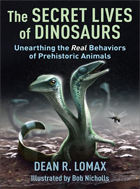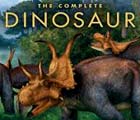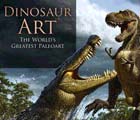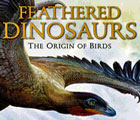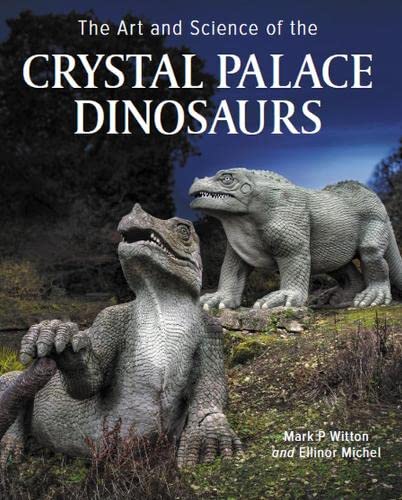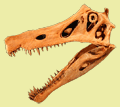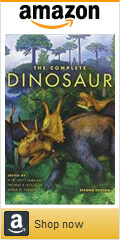Pronunciation: SPIEN-o-SOR-uh-day
Author: Stromer
Year: 1915
Meaning: Spined lizard family
Locomotion: Bipedal (2 legs)
Synonyms: Baryonychidae (Charig and Milner, 1986), Irritatoridae (Martill et al., 1996)
Author: Stromer
Year: 1915
Meaning: Spined lizard family
Locomotion: Bipedal (2 legs)
Synonyms: Baryonychidae (Charig and Milner, 1986), Irritatoridae (Martill et al., 1996)
[Sereno, 2005]Definition
The most inclusive clade containing Spinosaurus aegyptiacus but not Torvosaurus tanneri, Allosaurus fragilis and Passer domesticus (house sparrow).
About
Despite the name, not all spinosaurids (members of Spinosauridae) have long dorsal spines to support a hypothetical sail. They do, however, all have very long snouts with a "kink" towards the end and deep-rooted cone-like teeth. Design wise, their skulls were actually very crocodile-like and just like modern crocs they probably ate anything with a heart beat, from land or water, or perhaps even from the air as a spinosaurid tooth was found embedded in a pterosaur skeleton found in Brazil.
The first known spinosaurid was Spinosaurus, perhaps the largest predatory dinosaur that ever walked the earth, which was discovered by Stromer in Egypt in 1912. When the original remains were blown to hell during WWII bombing raids all scientists had to go on were a few notes and a photo of its ridiculously tall neural spines, but after the discovery of Baryonyx in England paleontologists were at last given the opportunity to crack the gag "why the long face?"
Spinosauridae is far from a large family but it's split into two groups - the Spinosaurinae and the Baryonychinae, with a combined total of a dozen or so members assigned to them over the years. Some have become synonyms of other members, others are considered dubious because of embarrassingly poor remains, and two (Irritator and Angaturama) could actually be based on material from the very same critter.
As well as their crocodile-like snout, sail, and fondness or fish, a 2010 study of oxygen isotopes in fossils by Romain Amiot and colleagues found that the bones of spinosaurids were more akin to turtles and crocodiles than to other theropod dinosaurs, which suggests they may have spent at least some of their lives in water. Nizar Ibrahim took this theory much further in 2014, insisting Spinosaurus were semi if not fully aquatic, which has met with some stiff opposition. Given their solid bones and thus lack of buoyancy control, Spinosaurus would likely bound along river beds like hippos rather than paddle like ducks, if indeed they were water dwellers.
Click here to view Dinochecker's A-Z list of Spinosaurids.
Etymology
Spinosauridaae is derived from the Latin "spina" (spine), and the Greek "sauros" (lizard) and "-idae" (family), named for the group anchor Spinosaurus.
Relationships
Further reading
• Stromer E (1915) "Ergebnisse der Forschungsreisen Prof. E. Stromers in den Wüsten
Ägyptens. II. Wirbeltier-Reste der Baharîje-Stufe (unterstes Cenoman). 3. Das Original des Theropoden
Spinosaurus aegyptiacus nov. gen., nov. spec." [Results of Prof. E. Stromer's Research Expedition in the Deserts of Egypt II. Vertebrate Remains from the Baharîje Beds (lowermost Cenomanian)
3. The Type of the Theropod Spinosaurus aegyptiacus
nov. gen., nov. spec.]. Abhandlungen der Königlichen Bayerischen Akademie der
Wissenschaften, Mathematisch-physikalische Klasse 28(3): 1-32.  • dal Sasso C, Maganuco S, Buffetaut E, Mendez MA (2005) "New information on the skull of the enigmatic theropod Spinosaurus, with remarks on its sizes and affinities". Journal of Vertebrate Paleontology 25.
DOI: 10.1671/0272-4634(2005)025[0888:NIOTSO]2.0.CO;2
• Amiot R, Buffetaut E, Lécuyer C, Wang X, Hutt S, Boudad L, Ding Z, Fourel F, Sweetman S, Martineau F, Medeiros A, Mo J, Simon L, Suteethorn V, Zhou Z, Tong H and Zhang F (2010) "Oxygen isotope evidence for semi-aquatic habits among spinosaurid theropods". Geology 38:139-142. DOI: 10.1130/G30402.1
• Buffetaut E, Martill D and Escuillié F (2004) "Pterosaurs as part of a spinosaur diet". Nature, 430(6995): 33.
DOI: 10.1038/430033a.
• Holtz jr TR, Molnar RE and Currie PJ (2004) "Basal Tetanurae" in Weishampel, Dodson and Osmólska's "The Dinosauria: Second Edition".
• Ibrahim N, Sereno PC, Dal Sasso C, Maganuco S, Fabri M, Martill et al. (2014) "Semiaquatic adaptations in a giant predatory dinosaur". Science. 345 (6204): 1613-6. DOI: 10.1126/science.1258750
• Hone DWE and Holtz jr TR (2017) "A Century of Spinosaurs - A Review and Revision of the Spinosauridae with Comments on Their Ecology". Acta Geologica Sinica 91(3): 1120-1132.
• Myhrvold NP, Sereno PC, Baumgart SL, Formoso KK, Vidal D, Fish FE and Henderson DM (2022)
"Spinosaurids as 'subaqueous foragers' undermined by selective sampling and problematic statistical inference".
bioRxiv 2022.04.13.487781 (preprint).
DOI: 10.1101/2022.04.13.487781
• D'Amore DC, Johnson-Ransom E, Snively E and Hone DWE (2024) "Prey size and ecological separation in spinosaurid theropods based on heterodonty and rostrum shape". The Anatomical Record: 1–18. DOI: 10.1002/ar.25563.
• dal Sasso C, Maganuco S, Buffetaut E, Mendez MA (2005) "New information on the skull of the enigmatic theropod Spinosaurus, with remarks on its sizes and affinities". Journal of Vertebrate Paleontology 25.
DOI: 10.1671/0272-4634(2005)025[0888:NIOTSO]2.0.CO;2
• Amiot R, Buffetaut E, Lécuyer C, Wang X, Hutt S, Boudad L, Ding Z, Fourel F, Sweetman S, Martineau F, Medeiros A, Mo J, Simon L, Suteethorn V, Zhou Z, Tong H and Zhang F (2010) "Oxygen isotope evidence for semi-aquatic habits among spinosaurid theropods". Geology 38:139-142. DOI: 10.1130/G30402.1
• Buffetaut E, Martill D and Escuillié F (2004) "Pterosaurs as part of a spinosaur diet". Nature, 430(6995): 33.
DOI: 10.1038/430033a.
• Holtz jr TR, Molnar RE and Currie PJ (2004) "Basal Tetanurae" in Weishampel, Dodson and Osmólska's "The Dinosauria: Second Edition".
• Ibrahim N, Sereno PC, Dal Sasso C, Maganuco S, Fabri M, Martill et al. (2014) "Semiaquatic adaptations in a giant predatory dinosaur". Science. 345 (6204): 1613-6. DOI: 10.1126/science.1258750
• Hone DWE and Holtz jr TR (2017) "A Century of Spinosaurs - A Review and Revision of the Spinosauridae with Comments on Their Ecology". Acta Geologica Sinica 91(3): 1120-1132.
• Myhrvold NP, Sereno PC, Baumgart SL, Formoso KK, Vidal D, Fish FE and Henderson DM (2022)
"Spinosaurids as 'subaqueous foragers' undermined by selective sampling and problematic statistical inference".
bioRxiv 2022.04.13.487781 (preprint).
DOI: 10.1101/2022.04.13.487781
• D'Amore DC, Johnson-Ransom E, Snively E and Hone DWE (2024) "Prey size and ecological separation in spinosaurid theropods based on heterodonty and rostrum shape". The Anatomical Record: 1–18. DOI: 10.1002/ar.25563.





